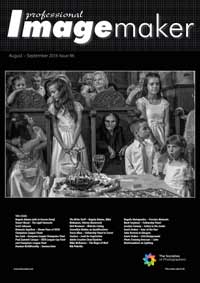articles/Lighting/one-light-rev-page3
One Light Revisited - part 3 of 1 2 3
by Dave Montizambert Published 01/08/2016
To deal with the blind aspect of this exercise - you can't see where the light is going - I positioned my head in various spots over the set to check to see if the light from the Vivitar was striking these areas. For instance, to make sure it hits the background from edge to edge I look through my viewfinder, then by trial and error, or the help of a willing assistant, mark with tape (just slightly out of frame) the four corners of the wall that the camera sees. Once the main panel was brought in, I placed my head against one of the pieces of tape on the background at the end of the wall furthest from the Vivitar.
This way I could see if the panel would block any light from the wall which would create an unwanted dark area on the background in the image. Also I stood where the subject would stand and then looked toward the Vivitar to make sure that I could not see it, that is to say, I make sure that the panel totally blocks it to ensure that all light striking my subject comes through the white nylon fabric and not directly from the raw Vivitar light. With that position established I place a piece of tape on the floor and instructed Emma not to stray from that spot.
So a rather interesting exercise. Here's a few final thoughts: A single off-camera flash started out lighting both background and subject simultaneously which makes it impossible to over-expose the background to pure white while maintaining a correctly exposed subject. So think differently, invert your point of view, such as, 'If I can't increase light on the background then why not make the subject darker by decreasing the light falling on her then open up for the loss of light on her'. And if that isn't enough to over-expose the background to pure white, then add more diffusion material to the panel, or move the panel away from the subject a little, or feather the Vivitar a little off the panel and more onto the background, or 'soft-edgegobo' the Vivitar from the panel, in other words find a way to darken just the subject. And on the topic of flash power, the power of a light is relative, the Vivitar is not strong compared to my studio strobes, but at 800 ISO at f 5.6 it is plenty powerful. Also many studio
strobes vignette some of the exposure at a flash-sync shutter-speed of 1/200th. One brand of strobes I have shouldn't really go above 1/100th so off-camera flash does have a small advantage here since they all seem to sync nicely up to 1/200th, a good feature when shooting in a location, as I was on this shoot, where lots of windows and sky-lights were allowing light from outdoors onto the set. And finally, the background doesn't have to be white to start with, I have done this one-light set-up on a middle-grey wall, and using the above techniques, over-exposed it to pure white. Theoretically the wall could even be black, but that would be a painful task to set things up to over-expose it to pure white, even my cup is not that half full.
Want to see a movie of the above, go to www.montizambert.com 'Dave On Demand'.
Please Note:
There is more than one page for this Article.
You are currently on page 3 Contact Dave Montizambert
1st Published 01/08/2016
last update 09/12/2022 14:57:08
More Lighting Articles
There are 17 days to get ready for The Society of Photographers Convention and Trade Show at The Novotel London West, Hammersmith ...
which starts on Wednesday 14th January 2026





